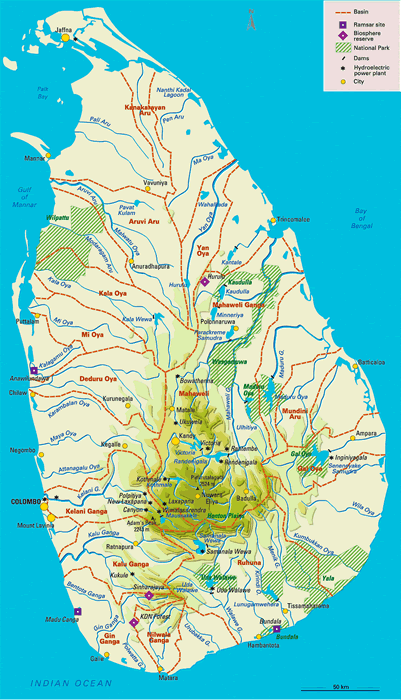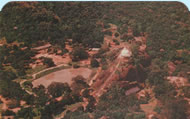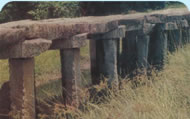Notwithstanding the recent much hyped up reports on oil exploration off the Mannar Basin in Sri Lanka, it has been found, Sri Lanka is already sitting on a large bed of another kind of an emerging strategic resource, Water.
Read full article here - Water profile of Sri Lanka
The story of Ancient Sinhalese Irrigation Works
(Quoted from an "Ilankai Tamil Sangam" ie. Association of Tamils of Sri Lanka, Website article published on January 13, 2010)

Above: The network of all river systems in Sri Lanka (Image courtesy - Tamil Sangam)
Sri Lanka is a classic example of the "hydraulic civilization" which had developed in the ancient period. With the immigration of Aryans from Eastern India to Lanka in 543 BC, cultivation of rice developed into a grand scale in the island. As the new essentially agricultural Aryan civilization flourished, increasingly ambitious projects of irrigation were launched at a pace with a view to harness the monsoon rains. It can be safely deduced that the first great reservoirs ever in the world were built in Sri Lanka. Since the great lakes of Egypt, being merely natural hollows into which streams were turned do not fall into the category of man-made rainwater reservoirs as those of Lanka.
The rainwater reservoirs developed in the ancient kingdom of Anuradhapura (437 BC-845 AD) & Polonnaruwa (846 AD-1302 AD), Dry Zone of central lowlands resulted in two season of farming while the Wet Zone remained sparsely populated and covered by thick forests. Today around 12,000 ancient small dams & 320 ancient large dams together with thousands of man-made lakes dot the lowlands, with over 10,000 reservoirs in the Northern Province alone. Today Ancient Sinhalese irrigation supplemented by Modern Irrigation Projects continue to provide the lifeline: self sufficiency in rice, the staple food of the Sri Lankans.
The vast reservoirs depict the rich cultural heritage of the unbroken recorded civilization of the Sinhalese. Furthermore, in the context of wetlands, it must be noted that non existence of natural lakes in the tropical island of Sri Lanka was compensated by the man-made lakes. The major (ancient & modern) irrigation reservoirs (each more than 200 ha) cover an area of 87854 ha, while the seasonal/minor (ancient) irrigation tanks (each less than 200 ha) account for 52250 ha.
The first rainwater reservoir

The first modest works of hydraulic engineering dates back to earliest days of the Sinhalese civilization of the Island.
300 BC Ancient Bisokotuwa (Queen enclosure) Vs. Modern Sluice gate
The finest example of the ingenuity of the Sinhalese irrigation engineering is the invention of the "Biso-kotuwa" (meaning queen's enclosure in Sinhalese) in 3rd century B.C. Biso-kotuwa is the equivalent of the modern valve-pit, which operates in the regulation of the outward flow of water. It was the invention of biso kotuwa which permitted the Sinhalese to proceed boldly with the construction of vast reservoirs that still rank among the finest and greatest work of its kind in the world.
A Bisokotuwa

The great royal tank builders of ancient Lanka
King Abhaya (474-453 BC): first rainwater reservoir of the island was built
King Pandukabhaya (437-366 BC): Abhayawewa (Basawakkulama wewa) rainwater reservoir was built in Anuradhapura
King Vasaba (65-108 AD): The first major irrigation works were launched by king Vasaba. King Vasaba was responsible for construction of a dozen irrigation canals & eleven tanks, the largest with a circumference of three kilometers.
King Mahasena (276-303 AD): The first giant reservoirs were constructed by King Mahasena. The vast Minneriya tank & fifteen other reservoirs were constructed by the king Mahasena.
King Dhatusena (461-478 AD): The vast Kala Wewa rainwater reservoir & remarkable 90km long Jaya Ganga (also called Yoda Ela) canal with a subtle gradient of 1 ft per mile was built by King Datusena
King Moggalana (497-514 AD): The Padviya tank built by King Moggalana became the largest tank at the time. Today following restoration it is slightly smaller than Kalawewa & Minneriya weva.
King Aggabodhi the third (623-639 AD): The Giritale tank & several other tanks were built by King Aggabodhi the third
King Dappula the second (807-811 AD): Panduwewa (Pandu water reservoir) built by King Dappula the second
King Parakrambahu the great (1164-1196 AD) The royal master builder of tanks
During the reign of the great king, Lanka became to be known as the Granary of the Orient. King Parakramabahu the great was responsible for construction or the restoration of 165 dams, 3910 canals, 163 major tanks (=reservoirs) and 2376 minor tanks, all in a reign of 33 years, achieving supreme developments in irrigation and agriculture of the Sinhalese civilization during its 2550 year long history.
The Parakrama Samudra

(The Sea of Parakrama = Parakrama Samudra)
Minneriya Tank

Irrigation Canals

Network of canals to surrounding area
One of the canals (Yoda Ela, also called Jaya Ganga), the ancient engineers demonstrated their prodigious skill maintaining a steady gradient of less than 20cm per kilometer (1 ft per mile) over distances that eventually stretched to 80 km (50 miles).
The Dams
The dams were built at an oblique angle, exposing the masonry to a lesser degree of violent shocks caused by impact of large floating tree trunks and other debris.
Decline of the ancient Hydraulic civilization of Sri Lanka
Quote
(A. Dennis N. Fernando - Fellow National Academy of Sciences)
The fall of the ancient hydraulic civilization of Sri Lanka in the 13th century was due to sudden Natural Cataclysmic change of the river course of the Mahaweli Ganga & was not due to foreign invasions as historians would want us to believe. The scientific evidence is clearly seen in the aerial photographs of the old course of the Mahaweli Ganga & its new river courses. The ancient Mahaweli with its ancient chaityas which were beside the old river like a string of pearls now lay stranded beside it. While the present river flows elsewhere with no chaityas beside it which event took place in circa 1220 AD. This sudden geological cataclysm that changed the river course that sustained our ancient hydraulic civilization, led to disease & famine. This resulted in the major part of the population to abandon these areas & move to the Wet & Intermediate Zones where the king also established himself at Dambadeniya, Kurunagala, Gampola, Kotte & Kandy.
Unquote.
'Chaityas' is another name for stupas (dagobas)
Further Decline of Ancient irrigation schemes during British Colonialism (1815-1948) in Ceylon
During the early period of British rule the colonial administration was pre-occupied with military & political consolidation, & thereafter, with capitalist enterprise in plantation exploiting the riches of the island supplanted cultivation of rice with cash crops, first coffee & then Tea & Rubber. With no interest taken & no support extended to the farmers on irrigation of paddy fields, the tanks gradually fell into disrepair, turning much of the countryside into malarial swampland. A modern historian calls this a "regrettable but understandable situation, given the fact that the higher bureaucracy itself had been so deeply involved in plantation agriculture"
To give the devil his due credit, we must hasten to add that the Sir Emerson Tennent (1843-1850) a Colonial Secretary, who authored the famous book CEYLON-An Account of the Island (1859), focused attention on the importance of irrigation. The British governor, Sir Henry Ward (1855-1869) deserves to be greatly remembered for his enlightened irrigation policy & his insight into the psychology of the Sinhalese farmer. Ward restored some of the ancient irrigation works, stating that the British administrators before him had "...never devoted a fair proportion of the revenue towards the restoration of old works... & the one thing that comes home to every Sinhalese is the improvement of those means of irrigation which the climate rendered indispensable...
Rehabilitation of ancient rainwater reservoirs
The dire situation of the island resulted in a national independence movement taking root over the issues of land, irrigation & cultivation. Having realized the gravity of the situation, during the second half of the 19th century & first half of the 20th century, the British colonialists launched on a project of restoration of ancient rainwater reservoirs. Restoration of the major Kala Wewa rainwater reservoir with a capacity of nearly 145 million cbm was carried about during 1885 to 1887.
Following the independence from the British in 1948, the rehabilitation of major ancient irrigation works has been accelerated by the national leaders of the independent Ceylon.
Largest ancient rainwater reservoirs
The Sea of Parakrama (2100 ha), Kaudulla (2537 ha), Minneriya (2550 ha), Huruluwewa (2125 ha), Kala Wewa rainwater reservoir (2583 ha), Mahakanadarawa (1457 ha), Nachchaduwa (1785 ha), Padaviya (2357 ha), Rajangana (1600 ha)
Large and medium reservoirs
73 major irrigation reservoirs (ancient) covering an area of 70850 ha
160 Medium scale reservoirs (ancient) covering an area of 17004 ha
10000 minor irrigation reservoirs (ancient) covering an area of 39271 ha
Floodplain lakes covering an area of 4049 ha
Ancient irrigation Vs Modern irrigation
"Many are the instances where the modern engineer has frequently found himself anticipated by an unnamed predecessor" Ceylonese historian R. L Brohier
Gal Oya Scheme
In 1952, modern Gal Oya Scheme testified to the brilliance of the ancient masterminds of irrigation engineering in Lanka: the discovery of remnants dated back to 1500 years of a dam site and two sluices almost exactly at the locations determined for the new reservoir by the engineers at the Gal Oya project. In order to preserve the excavated ruins of the dams & sluice gates, the priceless archeological findings, the government decided to move the new dam site to another location.
Maduru - Oya reservoir
In 1978 when modern engineers cleared the jungle to pave the way for the modern Maduru-Oya reservoir they stumbled on an ancient breached earth dam at the very spot where engineering experts had decided to straddle the river. This dam a little over 23 meters high has been dated to be over 2000 years old & indicates the existence of a vast reservoir before its breach.
© 1996-2010 Ilankai Tamil Sangam, USA, Inc.(http://www.sangam.org)
No comments:
Post a Comment